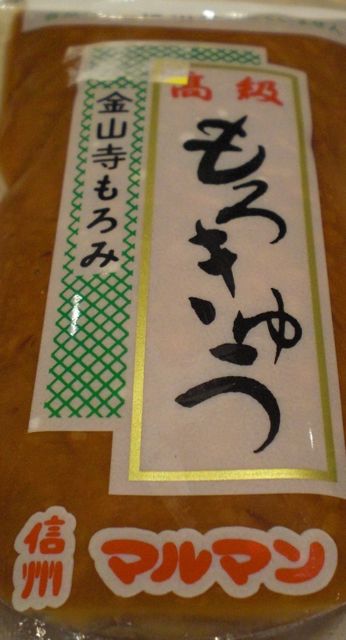This is a teiban 定番 or regular dish in Izakaya. It is very simple dish and this is not a recipe
per se; essentially serving cucumber and a special type of miso called
moromi miso もろみ味噌 together. It is called "moromi miso kyuri" もろみ味噌きゅうり but it is, almost always, shortened as "morokyu" もろきゅう. The quality of the cucumber is most important. Fresh and firm Japanese cucumber is the best but it is not always easy to get that kind of cucumber in the U.S. It is also interesting to see how Izakayas in different regions serve this dish. For example, last time we were in Japan, we had this in three different Izakayas; one in Kanazawa and two in Kyoto. In Kanazawa, they just served it cut in a long sticks but it was nicely chilled and very crispy. In Kyoto both Izakayas added decorative cuts like I did here as though they feel that an extra touch is need to charge whatever they charge for this dish. I would like to mention another encounter we had in
Torihachi とり八 in Kyoto. After we ordered and ate morokyu, a couple (obviously just coworkers or acquaintances) sitting next to us at the counter decided to order one. After receiving the morokyu, the man pontificated on how the decorative cuts could be done (which is far from how this is actually done) and appeared not really interested in eating the dish. We had a chuckle overhearing this.
Especially since I used American mini-cucumbers (my excuse), I did not do a great job of this decorative cut which supposedly mimicking a pine tree. This decorative cut was shown for the first time to us by one of the sushi chefs at Mikado in Tenleytown area of DC, a Japanese restaurant we used to frequent, which has been closed for over 10 years after their losing the lease and the owner decided to retire.
To prepare this dish, I just soak cucumbers (use Japanese or mini-cucumber, American and English cucumber are not suitable for this) in ice water (with ice cubes) for 5-10 minutes to chill and crisp it. After drying the surface, you can cut in long st

icks by quartering lengthwise or, like I did here, cut in half in both length- and width-wise with the decorative cut. You could use different types of decorative cuts as well. If you are interested in how this and other decorative cuts using cucumbers are done,
please watch this video.
Moromi miso もろみ味噌 is a special kind of miso with fermented rice , wheat or barley, and sometimes with other added vegetables. It tastes salty, sweet and a bit nutty. It is meant to be eaten as a condiment or for dipping but not for seasoning dishes or soup. You could buy it in any Japaneses grocery store and it usually comes in a small plastic pouch (see above) or in a jar. The one I got this time is called "Kinzanji-moromi" 金山寺もろみ which is best known in Wakayam 和歌山 prefecture but this one appears to have come from shinshu 信州 which is Nagano 長野 prefecture.
To eat, just pick up the cucumber and using chopsticks, place and spread a small dab of moromi miso and eat. It is nice refreshing dish in-between other dishes. I have to say, though, nothing matches freshly harvested Japanese cucumber, with a much darker green skin and still having small prickly surface, but this has to do as a good second best. You could also serve sticks of celery, carrots, or other fresh vegetables with moromi miso.


